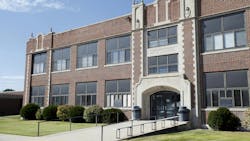How to Address Student Safety and School Sustainability Strategically
Higher education facilities spend a combined $6 billion each year on energy, with this number only increasing with inflation and the price of fossil fuels continuing to rise. While sustainability has become an emerging priority across sectors, the study shows many in education still haven’t engaged, especially with tight budgets, delaying these projects. In fact, a survey conducted by Brightly found that 69% of respondents say ESG isn’t a high priority and 53% don’t have an ESG strategy in place.
As higher education decision-makers face extreme climate events and shrinking budgets, sustainability must remain at the forefront. This article will explore how facilities managers can ensure infrastructure and asset upgrades will contribute to sustainability goals—and, in turn, fiscal goals—starting with a strategic approach to asset management.
Understanding Facilities’ Environmental Impact
With poor infrastructure grades for higher education and environmental challenges impacting student learning and safety, education facilities managers are feeling an increasing urgency to ensure the health of their assets. They must consider not only how to proactively address short-term infrastructure upgrades but also how to plan for weather-related emergencies that could close schools. For example, some college campuses in Florida were closed for nearly two weeks due to Hurricanes Ian and Nicole in fall 2022, and some were closed for a few days due to Hurricane Idalia in August 2023, potentially followed by more this upcoming hurricane season.
Creating an asset management strategy that incorporates sustainability must begin by identifying where inefficiencies are happening so facilities managers can address the root cause, saving money in the long run. Utilizing technology to gather real-time data on all aspects of facilities—from air conditions and HVACs to heating systems—enables maintenance and operations leaders to gain insight into the state of their assets, providing proof-points to support decisions about asset health.
Beyond increasing transparency and communication with stakeholders, this data provides tangible details about where utility waste might be happening, which assets need to be repaired or replaced—and when—and where to direct critical funds. In fact, prioritizing sustainability initiatives may also help with college enrollment, with 45% of perspective students ultimately considering environmental sustainability in their college decision.
Saving Energy on Aging Infrastructure
According to the last report card from the American Society of Civil Engineers, American infrastructure was graded a C-, and while students' health and safety have always been a top priority for professors, administrators, and facilities professionals, the COVID-19 pandemic put both primary and secondary assets at the forefront as it shed light on concerns of aging infrastructure. According to the U.S. Energy Information Administration, the average age of campus buildings is about 35.5 years and continues to increase, putting students at greater risk of health and safety issues.
Along with these concerns, in 2021, APPA estimated that American higher ed campuses possessed facility backlogs north of $112 billion, underscoring the urgent need for advanced technologies to manage and address these issues. This comes at a time where higher education institutions are also being hindered by budget cuts, with schools such as Pennsylvania State University, University of Connecticut, and the University of New Hampshire each facing multimillion-dollar funding losses earlier this year. By investing in technology solutions, higher education institutions can help streamline facility management, prioritize infrastructure upgrades, and effectively tackle these backlogs.
So, what can be done about these infrastructure challenges? Facilities managers are likely to see renewed interest in infrastructure with the U.S. Department of Education’s Research and Development Infrastructure Grant Program, introduced in early 2024. This program offers a promising solution by providing funding for Historically Black Colleges and Universities, Tribal Colleges and Universities, and Minority-Serving Institutions to improve higher education infrastructure. It supports upgrades to campus facilities, enhances physical infrastructure, and aids in the development of research centers and institutional support structures. By targeting these areas, the program aims to address critical infrastructure needs and improve overall campus conditions.
The Road Ahead
College and university facilities account for 5% of U.S. commercial building emissions and comprise over 5 billion square feet of space, leading to nearly $14 billion in annual energy costs. Estimates suggest that sustained efforts in the higher education sector could yield more than $1 trillion in energy savings over 10 years, according to Global Philanthropy Partnership.
University campus utility costs continue to increase year over year. To avoid about 25% of those energy and operational expenses, education facility decision-makers must invest in long-term sustainability solutions, such as asset investment planning software (AIP). As facility and operational leaders manage with fewer resources to maintain safe and healthy campuses, the right technology can enhance efficiency, enable strategic planning for sustainable infrastructure updates, and optimize fund usage.
The long-term benefits of putting such sustainability initiatives into play go beyond the immediate cost savings. They enhance student health and safety, improve campuses, and create a positive impact on campus reputation and student recruitment. While the challenges may be significant, the opportunity and potential outcomes are equally substantial.
About the Author
Katie Gramajo
Katie Gramajo, CEFP, is the Senior Education Sector Expert at Brightly Software, a Siemens company.
